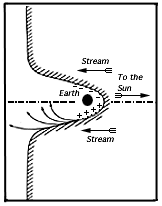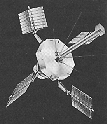|
[an error occurred while processing this directive]
#19H. The Magnetopause -- History
|
(Files in red–history)
|
But how did the Sun exert its influence? Early ideas that the Sun sent out streams of electrons (which also produced the aurora) were given up when it was realized that the unbalanced negative electric charge of such electrons would completely disrupt the process.
The Chapman-Ferraro Cavity Then in 1930 a different idea was proposed by Sidney Chapman in England and by his younger associate Vincent Ferraro: that the Sun sent out huge clouds of electrically neutral plasma, and that magnetic storms arose when those clouds enveloped the Earth. Many magnetic storms were observed to begin with a "sudden commencement," a small step-like jump in the magnetic field observed all over the world, taking just a minute or so. Chapman and Ferraro proposed that such jumps marked the cloud's arrival.
|
|
They realized that the strong field of the Earth would hold off the cloud, carving a cavity in the cloud in which the Earth and its magnetic field would be confined (see drawing above, from their 1931 article). They also speculated that a ring current would then be set up, though they had no clear idea of the way it happened. The theory of the "Chapman-Ferraro Cavity" proved to be prophetic, except for one important detail: the flow of plasma from the Sun was not confined to isolated clouds, but went on all the time, in the form of the solar wind. Denser and faster clouds, such as arise from coronal mass ejections (see corona), were later identified as the real cause of sudden commencements.
Further reading:
Questions from Users: *** Does our magnetic field stop the atmosphere from getting blown away? *** Blocking of the Solar Wind by our Moon? |
Next Stop: #20. Structure of the Earth's Magnetosphere
- Back to the Index Page
Timeline Expanded timeline Glossary
Author and Curator: Dr. David P. Stern
Mail to Dr.Stern: education("at" symbol)phy6.org
Co-author: Dr. Mauricio Peredo
Spanish translation by J. Méndez
Re-formatted 3-13-2006

